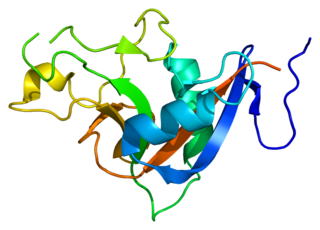
Interleukin 1 beta (IL-1β) also known as leukocytic pyrogen, leukocytic endogenous mediator, mononuclear cell factor, lymphocyte activating factor and other names, is a cytokine protein that in humans is encoded by the IL1B gene. There are two genes for interleukin-1 (IL-1): IL-1 alpha and IL-1 beta. IL-1β precursor is cleaved by cytosolic caspase 1 to form mature IL-1β.

Interleukin-22 (IL-22) is protein that in humans is encoded by the IL22 gene.

Interleukin 8 receptor, alpha is a chemokine receptor. This name and the corresponding gene symbol IL8RA have been replaced by the HGNC approved name C-X-C motif chemokine receptor 1 and the approved symbol CXCR1. It has also been designated as CD181. The IUPHAR Committee on Receptor Nomenclature and Drug Classification use the HGNC recommended name, CXCR1.

PDX1, also known as insulin promoter factor 1, is a transcription factor in the ParaHox gene cluster. In vertebrates, Pdx1 is necessary for pancreatic development, including β-cell maturation, and duodenal differentiation. In humans this protein is encoded by the PDX1 gene, which was formerly known as IPF1. The gene was originally identified in the clawed frog Xenopus laevis and is present in many species across the bilaterian phylogeny. In particular, PDX1 orthologs have been identified in most mammals.

Interleukin 1 receptor, type II (IL-1R2) also known as CD121b is an interleukin receptor. IL1R2 also denotes its human gene.

Interleukin 12 receptor, beta 2 subunit is a subunit of the interleukin 12 receptor. IL12RB2 is its human gene. IL12RB2 orthologs have been identified in all mammals for which complete genome data are available.

Interleukin 21 receptor is a type I cytokine receptor. IL21R is its human gene.
Neurogenins are a family of bHLH transcription factors involved in specifying neuronal differentiation. It is one of many gene families related to the atonal gene in Drosophila. Other positive regulators of neuronal differentiation also expressed during early neural development include NeuroD and ASCL1.

Interleukin-2 receptor subunit beta is a protein that in humans is encoded by the IL2RB gene. Also known as CD122; IL15RB; P70-75.
Insulitis is an inflammation of the islets of Langerhans, a collection of endocrine tissue located in the pancreas. The islets containing the pancreatic β-cells, and in some cases, the exocrine tissues, become infiltrated by T and B lymphocytes, macrophages and dendritic cells. This innate immune cell and lymphocyte infiltration can result in destruction of the insulin producing beta cells of the islets, and clinical diabetes. Insulitis is often studied in the multiple low dose streptozotocin (MLDS) mouse model or the non-obese diabetic (NOD) mouse model of type 1 diabetes. The chemokine family of proteins may play a key role in promoting leukocytic infiltration into the pancreas prior to pancreatic beta-cell destruction.

Regenerating islet-derived protein 3 gamma is a protein that in humans is encoded by the REG3G gene.

Neurogenin-3 is a protein that in humans is encoded by the NEUROG3 gene.
Freund's adjuvant is a solution of antigen emulsified in mineral oil and used as an immunopotentiator (booster). The complete form, Freund's Complete Adjuvant is composed of inactivated and dried mycobacteria, whereas the incomplete form lacks the mycobacterial components. It is named after Jules T. Freund.
Helper T cells are essential part of body's immune system. These cells are divided in many subsets based upon their ability to produce different cytokines. Following the discovery of interleukin-17 (IL-17) producing T helper (Th17) cells as a distinct lineage of T helper cells it became clear that these cells play an important role in the host defense and participate in the pathogenesis of many inflammatory and autoimmune diseases. The Th17 cells can alter their differentiation program ultimately giving rise to either protective or pro-inflammatory pathogenic cells. The protective and non-pathogenic Th17 cells are termed as Treg17 cells.

Pancreatic progenitor cells are multipotent stem cells originating from the developing fore-gut endoderm which have the ability to differentiate into the lineage specific progenitors responsible for the developing pancreas.

Islet resident macrophages are the predominant myeloid cell of the pancreatic islets of langerhans.













